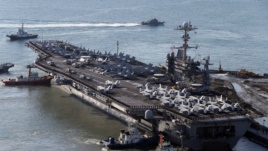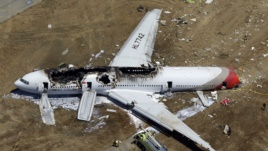VOA慢速英语:美国军方在太平洋海域巡航
Hello, and welcome to As It Is from VOA LearningEnglish!
I’m Jim Tedder in Washington.
United States officials recently fined Asiana Airlines$500,000 for failing to help victims of a plane crash lastyear. Three people died and more than 180 wereinjured when the plane hit a seawall while landing inSan Francisco, California. US officials say Asianafailed to act quickly to assist the families of passengersinvolved in the crash. An earlier investigation found thecommunications among the plane’s crew membersmay have been an issue.
“Why would you have two pilots in the airplane if they aren’t going to talk toeach other?”
We will hear more about that later in the program. And we report on changesthe South Korean airline is making in its training for pilots.
But first, we have a progress report on President Barack Obama’s plan toincrease the US military’s presence in East Asia and the Pacific. Someofficials have described the move as a “pivot” to the Asia-Pacific area.
“We have to do better at being able to communicate with each other in a waythat allows us to not lead to miscalculation that won’t be productive in thesecurity environment.”
We are talking about pivots and pilots today on As It Is from VOA LearningEnglish.
US Military Continues “Pivot” to Asia-Pacific Area
Two years ago, President Obama announced plans to redirect America’sdefense policy. He said the military would reduce its presence in the MiddleEast, and instead send more forces to the Asia-Pacific area. But the USmilitary is now facing tests from China and its growing military power.
US military officials say American influence in the Asia-Pacific area is not growing weaker. But recent actionsby China show that influence is being tested. China’smilitary has established an aircraft identification zoneover the East China Sea. And in a recent incident,Chinese and US navy ships almost crashed into oneanother.
 |
| USS George Washington is escorted into a navy port in Busan, South Korea, Oct. 4, 2013. |
The Obama administration wants to move US forcesfrom wars in Iraq and Afghanistan to the Asia-Pacificarea. But China has been building up its forces in thePacific. It has sent a new aircraft carrier to the area, and developed newmissile technology.
Admiral Samuel Locklear is the commander of US forces in the Pacific. Hesays American and Chinese forces will likely increase their dealings with oneanother in the area. So he thinks the two militaries should increase theircontacts.
Defense experts question whether the American pivot to Asia has, in fact,resulted in a strengthening of forces in the Pacific. Barry Pavel is with theAtlantic Council in Washington, DC.
“We have the deployment of 2,500 or so Marines to northern Australia, that’ll be there on a routine basis, not a very big nor significant deployment in myestimation. There’s a couple of ships. I think they were littoral combat shipsthat were discussed as being home ported in Singapore, and then there reallyhasn’t been anything else.”
The US military has deployed a combat ship to Singapore. And it sent theaircraft carrier USS Ronald Reagan to replace another carrier at Yokosuka inJapan.
American officials say they could add more ships, equipment, and troops in the future.
But last month, the Obama administration announced plans to cut the USmilitary to its smallest size since the end of World War II. Experts say thatcould affect any future military moves in the Asia-Pacific area.
You are listening to As It Is. I’m Jim Tedder in Washington.
We now turn to our story about Asiana, South Korea’s second-largestpassenger airline. The company is changing its training for pilots in an effortto persuade crews to talk more openly. Steve Ember has our report.
Asiana Airlines Makes Changes in Pilot Training
Asiana Airlines wants to improve communication in the airplane’s cockpit – theenclosed area where pilots sit. An American investigation found that cockpitculture and pilot training may have been an issue in the crash of an Asianaplane last July.
“Tower, good morning. Asiana 214 on final, seven miles south…”
Asiana Flight 214, a Boeing 777, crash landed short of the runway at the SanFrancisco International Airport in California.
Radio Communication: “Everybody calling, stand by…”
Three people died and 180 others were hurt.
Tower Controller: “United 885, roger, we have emergency vehiclesresponding.”
United Airlines Employee: “Between the runways, right adjacent to the [runway] numbers, we can see about two or three people that are moving andapparently survived.”
Controller: “Roger.”
 |
| Airliner Crash |
Last August, VOA was the first media organization to report that the crashcould be linked to the way pilots treat each other in the cockpit.
Usually, when such issues happen, it is a matter of pilots not wishing toquestion a decision, which they feel to be dangerous, when made by thecaptain, or senior pilot.
But the Asiana crash resulted from a different kind of failure to communicate.
The US National Transportation Safety Board held a hearing on it inDecember.
Investigators said the pilot making the landing was being trained by a moreexperienced “Triple-7” pilot, and was afraid to tell his training pilot that hewanted to cancel the landing and try again. This was because Korean culturewould not have allowed him to speak up, even though cockpit alarms weresounding, warning that the plane was at too low a speed and not correctlypositioned for landing.
Now, Asiana Airlines is changing the way it trains pilots. The company willurge more open discussion among pilots about flying decisions. Pilots willdepend less on years working for the company, military service or age.
David Kirstein works in aviation regulatory law for Kirstein and Young, aWashington-based law group.
“Why would you have two pilots in the airplane if they aren’t going to talk toeach other?”
He also says the new training does not surprise him.
“There’s probably pressure from US aviation officials, or the NTSB, or theirown government. There may be a fall-off in traffic that consumers are worriedabout if people aren’t flying. I mean that’s the most motivating factor there is.”
While many airlines have already put in place “Cockpit ResourceManagement,” the idea of open communication in the cockpit, the head ofAsiana Airlines has admitted that many of their pilots work and fly within astrict military order.
David Kirstein says other airlines should note the changes at Asiana. He saysthey also should understand the importance of open communication in thecockpit.
I’m Steve Ember.
Thank you, Steve.
We would like to know what you want to hear about on a future program. Justsend us a letter or a postcard. Our address is:
VOA Learning English
Washington, DC 20237 USA
Or send an e-mail to: LearningEnglish@VOANews.com
You can also go to our website, www.learningenglish.voanews.com, and click“Contact Us.”
- 频道推荐
- |
- 全站推荐
- 推荐下载
- 网站推荐




















